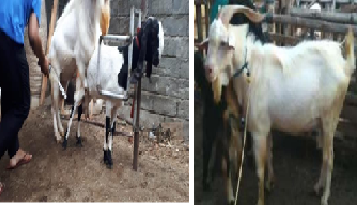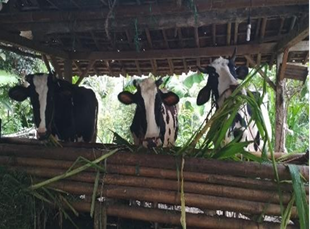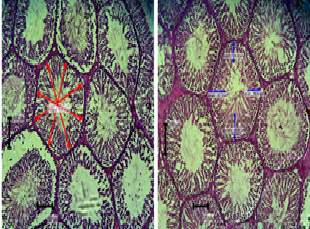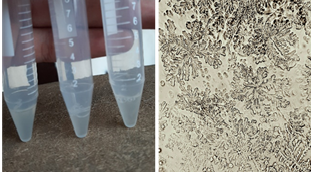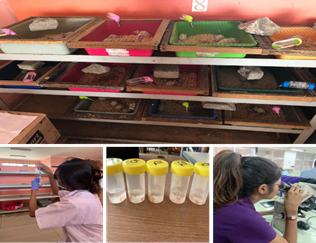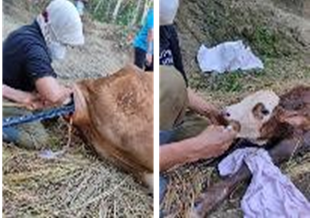Editorial Policies
- Aims and Scope
- Peer Review Process
- Publication Frequency
- Open Access Policy
- Archiving
- Publication Ethics
- Article Processing Charges
- Plagirism Screening
Aims and Scope
Aims
Ovozoa: Journal of Animal Reproduction publishes original scientific papers in the field of Basic Research, Biotechnology, Applied Research and Review Articles, with the goal of contributing to a better understanding of phenomena related to animal reproduction.
Scope
The scope of the Ovozoa: Journal of Animal Reproduction applies to students, lecturer, researchers and practitioners in the fields of veterinary, biology and animal science reproduction.
Peer Review Process
The chief editor and editors will evaluate the manuscripts submitted at the prequalification stage based on the format suitability and substance qualifications, and to scan for instances of plagiarism present in manuscripts will be conducted by means of Turnitin software. If there is a format discrepancy, the manuscript will be sent back to the corresponding author to be rewritten under the Ovozoa format. However, if there is a discrepancy in substance qualifications (not included in Ovozoa focus and scope), the manuscript is rejected without further review. The decision will change the status of the manuscript in the OJS. The chief editor will notify the corresponding author about the decision.
The prequalification stage constitutes a swift assessment conducted by the editorial team, focusing on the quality of the submitted manuscripts. This phase is pivotal for screening submissions to ensure they meet the requisite standards of excellence. Manuscripts that pass the prequalification will be evaluated by two or three reviewers determined by the chief editor and editors. The chief editor will send the manuscript to reviewers via OJS. The reviewers answer whether they would like to review the manuscript directly via OJS. The reviewers check the manuscript based on predetermined criteria and returns it with recommendations to the chief editor via OJS. If one reviewer recommends being accepted and another reviewer recommends being rejected, then the chief editor will ask the third reviewer or three editors to decide on the acceptance or rejection of the manuscript.
Manuscript reviews for publications in the Ovozoa Journal of Animal Reproduction (hereinafter referred to as Ovozoa) are carried out by peer reviewers in a double-blind review. The double-blind peer review process is a way to ensure impartiality and prevent any bias when reviewing. With a double-blind review, neither the author nor the reviewer knows who wrote the paper. This increases impartiality and prevents potential biases from influencing the reviewer's opinion. The chief editor handles all correspondence with the corresponding author and the reviewer, and leads the final decision on whether the manuscript is recommended to be accepted, rejected, or needs to be returned to the corresponding author for revision. The corresponding author will automatically receive a confirmation email after successfully submitting the manuscript through OJS.
The assessment results from the peer reviewers will be consolidated at least by two editors who match their expertise to make a decision.
1. Accepted without revisionsThe decision to accept the manuscript will change the status of the manuscript in the OJS. The chief editor will notify the corresponding author by e-mail if the manuscript is declared accepted and send the payment bill. At the same time, the manuscript was passed on to the editors for editing and layout. If payment has been made by the corresponding author, and, the editing and administration process has been completed, the chief editor will send a proof to the corresponding author via email for final correction and approval. Proof which has been approved by the corresponding author is determined to be published online in what volume and number (month and year edition).
2. Accepted with minor revisions, or major revisions, or must be rewritten.
The decision to revise the manuscript will change the status of the manuscript in the OJS. Manuscripts that require revision will be returned to the corresponding author via email, and the corresponding author must resubmit the revised manuscript through the OJS within the specified time period. Next, the chief editor sends the revised manuscript from the corresponding author to the editors to check whether the manuscript has been revised according to the reviewers' suggestions. Editors provide recommendations to the chief editor that the manuscript was accepted, or must be returned to the corresponding author to be revised again, or rejected.
3. Rejected
Manuscripts are rejected if based on consolidated comments it is concluded that
3.1. the corresponding author did not revise the manuscript as suggested by the reviewers and did not respond to the suggestion
3.2. based on the assessment of reviewers stated that
- originality and novelty in manuscripts for the advancement of science are considered inadequate,
- data is incomplete to prove the research hypothesis or the methodology used is incorrect,
- inconsistencies between objectives, research methods, results, and conclusions.
If the manuscript is rejected, the corresponding author will be notified by the chief editor via email through the OJS with a statement of reasons for the refusal.
Deadlines
1. Prequalification to determine the suitability of the format, as well as compliance with the focus and scope is for a maximum of two days
2. The review process by the peer reviewer is no more than 14 days
3. Editors make consolidated comments in no later than 7 days
4. Revisions by the corresponding author:
a. minor revisions: no more than 7 days
b. major revisions (must be rewritten): a maximum of 14-28 days.
Manuscripts that exceed the revision deadline will be canceled. When necessary, the corresponding author can request an extension of time to the chief editor before the revision period ends.
5. Editors assess and determine the revision decision no later than seven days.
6. The editing and layout process is a maximum of seven days.
7. Approval of proofreading of the manuscript final version from the corresponding author: a maximum of four days.
The time interval from the date the OJS manuscript submits until the decision of being rejected or accepted for publication varies, depending on the time required for the review and revision process. Decisions at the prequalification stage will be accepted by the corresponding author within two days after submitting through the OJS. Manuscripts that are accepted without revision will receive a notification no later than 37 days after the manuscript submission through OJS. Whereas, manuscripts with minor revisions, the acceptance or rejection will be decided in no later than 58 days, and for manuscripts with major revision in no later than 74 days after the manuscript submission through OJS. The time from submitting the manuscript to publishing is approximately 77 days.
Publication Frequency
Ovozoa Journal of Animal Reproduction (Ovozoa J AnimReprod) is published periodically three times a year (April, August, and December)
Open Access Policy
Ovozoa: Journal of Animal Reproduction provides immediate open access to its content by making researches freely available for public and supports a greater global exchange of knowledge.
Archiving
This journal utilizes the CLOCKSS system to create a distributed archiving system among participating libraries and permits those libraries to create permanent archives of the journal for purposes of preservation and restoration.
Publication Ethics
The Ovozoa Journal publishes scientific articles in the form of original research articles, review articles, and case reports on animal reproduction and animal reproductive biotechnology reviewed by Ovozoa Editorial Team. Published scientific articles expected to meet standards of academic excellence. It is necessary to equate stakeholders' views in an ethical standard to avoid problems in the future. The publication ethics is needed as a reference for Ovozoa Journal policies in publications, including the authors, editors (reviewers), reviewers (peer reviewers), and publisher.
Author
The author is required to submit the original work (no plagiarism) and not partially or fully published in other journals until the Ovozoa Journal provides an answer to the eligibility of the article.
Each name in the article must have a contribution to the research and the writing of scientific work, such as developing the concept, creating the design, collecting data, analyzing data, interpreting data, and making a conclusion. To those who play an essential role in the research but have no function as an author (example: funders), their names can be embedded in acknowledgments. The corresponding author is responsible for the research and writing of the manuscript.
Authors are required to cite the literature that affects the articles. The articles must follow the review process by reviewers and peer reviewers. Manuscripts that submit to the Ovozoa Journal are not being sent to other scientific journals, are not being assessed by a journal, or have never is published or are being planned to be published in other scientific journals. If a small part of the data has been published, the source must be given written thanks in the acknowledgment of the article. If the data is reprocessed from a source, permission from the author is needed. Approval of the Ethical Commission must be stated (number and institution) if the manuscript is constructed based on research using live animals.
If the author discovers and is aware of the article's mistakes or errors, they must notify the chief editor to withdraw, clarify, and correct the article. If necessary, the author must be willing to apologize for the mistakes. Requests to reduce, add, or change the author's composition for articles, must be approved by the chief editor and prepared before the article is published.
Reviewer
The reviewer plays a role in providing input and assisting the editors in making policies on the articles reviewed in addition to helping authors improve the quality of their articles.
The reviewer should inform the editors about the appropriateness and ability to review the articles sent to them. All articles which are undergoing an editing process must be kept confidential.
The editing process should be carried out objectively by giving a reason, and not criticizing the author personally. The reviewer must have no personal interest in the research conducted by the author or the research funder. If the article is not suitable enough to be published, the article's confidentiality must still be maintained, so others will not use it without the author's permission.
Editor
The editors are responsible and have full authority in accepting or rejecting a manuscript sent by the authors. An assessment of a manuscript must still prioritize the scientific value, leaving aside personal and commercial interests.
If the manuscript is not suitable enough to be published, the editors must keep the confidentiality of the manuscript, so that it is not used by others, unless they get permission by the authors. The editors must fully keep the principle of blind review.
Publisher
As the publisher of the Ovozoa Journal, Faculty of Veterinary Medicine, Universitas Airlangga, in collaboration with the Association of the Indonesian Veterinary Reproduction, always encourages editors to obey with predetermined scientific writing procedures.
The publisher, in collaboration with the authors and editors in charge of maintaining academic integrity throughout the publication process. The publisher also maintains the quality of the journal and provides policies that encourage the development of the journal.
Animal Ethics
Research involving experimental animals be carried out following animal ethics and welfare. Experimental animals must be appropriately treated and minimizing the pain that might arise during the treatment. The utilization of experimental animals must be following local, national, and international regulations. The authors must make a statement, including the name of the ethical authority and the consent number; the trial is carried out in compliance with animal ethics and welfare.
Article Processing Charges
Article Submission: 0.00 (IDR)
There is no article submission charge.
Article Publication: 0.00 (IDR)
There is no article publication charge. However, this policy will be reviewed annually and will be announced in advance if there are changes.
Plagiarism Screening
Plagiarism is the act of when one author uses another work/author (copying someone's prior ideas, processes, results or words) without permission, credit, or acknowledgment. The Ovozoa is strictly against any unethical act of copying or plagiarism in any form. Authors should ensure that they have written entirely original works. Ovozoa considers plagiarism as a serious offense and will blacklist authors who knowingly cite or use material from other published works without proper acknowledgment. Authors are recommended to use plagiarism checking program to check the similarity from prior publication before undergoing the review processes or before published. Every manuscript that is also submitted to this journal will be screened for plagiarism using Turnitin Program before submission or published by Ovozoa Editor
The following types of plagiarism are considered by Ovozoa :
1. Full Plagiarism: Previously published content without any changes to the text, idea and grammar is considered as full plagiarism. It involves presenting exact text from a source as one's own.
2. Partial Plagiarism: If content is a mixture from multiple different sources, where the author has extensively rephrased text, then it is known as partial plagiarism.
3. Self-Plagiarism: When an author reuses complete or portions of their pre-published research, then it is known as self-plagiarism. Complete self-plagiarism is a case when an author republishes their own previously published work in a new journal.
If plagiarism is detected by the editorial board member, reviewer, editor etc., in any stage of article process- before or after acceptance, during editing or at a page proof stage. We will alert the same to the author(s) and will ask them to rewrite the content or to cite the references from where the content has been taken until a similarity index of less than 30% is achieved, otherwise the article may be rejected.
If plagiarism is detected after publication, the Journals will conduct an investigation. If plagiarism is found, the competent authority of the Ovozoa Journal will contact the author's institute and funding agencies. The paper containing the plagiarism will be marked on each page of the PDF. Depending on the extent of the plagiarism, the paper may also be formally retracted.






























